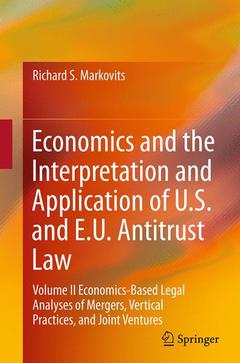Description
Economics and the Interpretation and Application of U.S. and E.U. Antitrust Law, Softcover reprint of the original 1st ed. 2014
Volume II Economics-Based Legal Analyses of Mergers, Vertical Practices, and Joint Ventures
Author: Markovits Richard S.
Language: English
Subject for Economics and the Interpretation and Application of U.S...:
94.94 €
In Print (Delivery period: 15 days).
Add to cartPublication date: 08-2016
Support: Print on demand
Publication date: 06-2014
705 p. · 15.5x23.5 cm · Paperback
Description
/li>Contents
/li>Biography
/li>Comment
/li>
Volume 2 uses the economic and legal concepts/theories of Volume 1 to (1) analyze the U.S. and E.U. antitrust legality of mergers, joint ventures, and the pricing-technique and contractual/sales-policy distributor-control surrogates for vertical integration and (2) assess related positions of scholars and U.S. and E.U. antitrust officials. Its analysis of horizontal mergers (1) delineates non-market-oriented protocols for determining whether they manifest specific anticompetitive intent, would lessen competition, or are rendered lawful by the efficiencies they would generate, (2) criticizes the U.S. courts? traditional market-share/market-concentration protocol, the HHI-oriented protocols of the 1992 U.S. DOJ/FTC Guidelines and the European Commission (EC) Guidelines, and the various non-market-oriented protocols the DOJ/FTC have increasingly been using, (3) argues that, although the 2010 U.S. Guidelines and DOJ/FTC officials discuss market definition as if it matters, those Guidelines actually reject market-oriented approaches, and (4) reviews the relevant U.S. and E.U. case-law. Its analysis of conglomerate mergers (1) shows that they can perform the same legitimate and competition-increasing functions as horizontal mergers and can yield illegitimate profits and lessen competition by increasing contrived oligopolistic pricing and retaliation barriers to investment, (2) analyzes the determinants of all these effects, and (3) assesses limit-price theory, the toe-hold-merger doctrine, and U.S. and E.U. case-law. Its analysis of vertical conduct (1) examines the legitimate functions of each type of such conduct, (2) delineates the conditions under which each manifests specific anticompetitive intent and/or lessens competition, and (3) assesses related U.S. and E.U. case-law and DOJ/FTC and EC positions. Its analysis of joint ventures (1) explains that they violate U.S. law only when they manifest specific anticompetitive intent while they violate E.U. law either for this reason or because they lessen competition, (2) discusses the meaning of an ?ancillary restraint? and demonstrates that whether a joint-venture agreement would be illegal if it imposed no restraints and whether any restraints imposed are ancillary can be determined only through case-by-case analysis, (3) explains why scholars and officials overestimate the economic efficiency of R&D joint ventures, and (4) discusses related U.S. and E.U. case-law and DOJ/FTC and EC positions. The study?s Conclusion (1) reviews how its analyses justify its innovative conceptual systems and (2) compares U.S. and E.U. antitrust law as written and as applied.
Introduction to This Study: This Study’s Coverage and Distinctive Features.- Chapter 12: Horizontal Mergers and Acquisitions.- Chapter 13: Conglomerate Mergers and Acquisitions.- Chapter 14: Vertical Mergers and the Pricing Techniques, Contract-of-Sale Provisions, and Sales-Policies That Are Surrogates For Vertical Integration.- Chapter 15: Joint Ventures and Other Types of Functionally-Analogous Collaborative Arrangements.
Richard Markovits, the John B. Connally Chair in Law at the University of Texas, has a Ph.D. in economics (London School of Economics) and an L.L.B. (Yale University). Markovits has taught in the law or economics faculties of six U.S., two U.K., and 5 German universities. From 1981-83, he was Co-Director of the Centre for Socio-Legal Studies at Oxford. He has also been a panelist for the U.S. NSF and the U.K. SSRC Economics Affairs Committee, a Guggenheim Fellow, and a Fellow of the Wissenschaftskolleg zu Berlin. Markovits has published 58 articles and two books – Matters of Principle (on jurisrprudence and constitutional law) (NYU, 2000) and Truth or Economics (on theoretical and applied welfare economics) (Yale, 2008).
lied than they differ as written
Is self-contained, combines sophisticated economic analysis with sophisticated legal analysis, provides clear operational definitions of all the economic and legal concepts it uses, relies primarily on verbal explanations, and when it uses mathematics, limits itself mathematically to arithmetical examples and two-dimensional diagrams
Volume II (Chapters 13 - 15)- see Volume I, ISBN 978-3-642-24306-6 (Chapters 1 - 14)
Explains why market definitions are inherently arbitrary, develops non-market-oriented approaches to assessing the monopolizing character and competitive impact of mergers, joint ventures, and long-term requirements contracts, and criticizes the market-oriented approaches to these issues proposed by academics and used by U.S. and E.U. courts and antitrust-enforcement agencies
Defines "oligopolistic" and "predatory" conduct, analyzes the determinants of the profitability of all variants of such conduct, examines the evidence that can and cannot be used to prove that defendants have engaged in them, and criticizes the contrary tests for predation and illegal oligopolistic conduct that academics and U.S. and E.U. courts and enforcement-agencies have proposed/used
Delineates the legitimate functions of vertical integration, (B) examines the ability of various horizontal pricing techniques, resale price maintenance, and vertical territorial restraints and customer-allocation clauses, other sorts of contractual provisions and sales policies that are designed to reduce independent retailers to promote a producer's product, and long-term full-requirements contracts can perform these functions, (C) examines the legal implications of the foregoing analyses under both U.S. and E.U. antitrust law, and (D) criticizes the contrary analyses and conclusions of scholars and U.S. and E.U. courts and antitrust-enforcement agencies
Provides a comprehensive account and comparison of U.S. antitrust law

